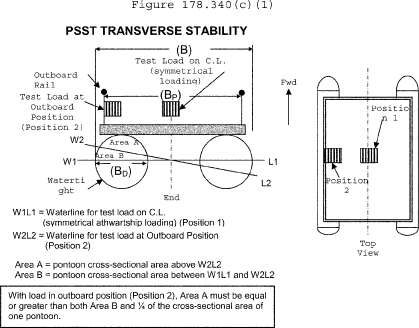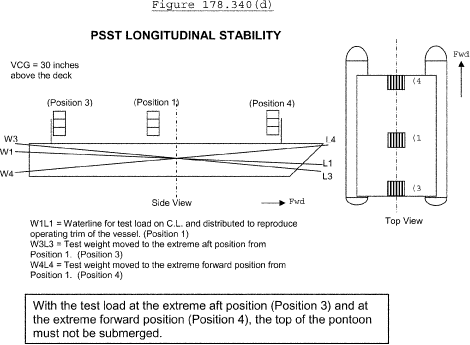Title 46
SECTION 178.340
178.340 Stability standards for pontoon vessels on protected waters.
§ 178.340 Stability standards for pontoon vessels on protected waters.(a) A pontoon vessel meeting the applicability requirements of § 178.320 of this part must be in the condition described in § 178.330(a) of this part when the PSST is performed, except that fuel, water and sewage tanks should either be empty or filled to 100 percent capacity, whichever is more conservative.
(b) A pontoon vessel must not exceed the limitations in paragraph (c) of this section when subjected to the greater of the following heeling moments:
Mpc = [(W)(Bp−K)]/2; or Mw = (P) (A) (H) Where: Mpc = passenger and crew heeling moment in foot-pounds (kilogram-meters); W = the total weight of passengers and crew aboard (total test weight) in pounds (kilograms); Bp = the maximum transverse distance of the deck accessible to passengers in feet (meters); K = 2.0 feet (0.61 meters); Mw = Wind heeling moment in foot-pounds (kilogram-meters) P = Wind pressure of 7.5 pounds/square foot (36.6 kilograms/square meter); A = Area, in square feet (square meters), of the projected lateral surface of the vessel above the waterline (including each projected area of the pontoons, superstructure and area bounded by railings and structural canopies); and H = Height, in feet (meters), of the center of area (A) above the waterline, measured up from the waterline.(c) With the appropriate heeling moment applied to the most adversely affected side of the vessel, the remaining exposed cross-sectional area of the pontoon must be equal to or greater than both -
(1) The cross-sectional area submerged due to the load shift (for an example, see Figure 178.340(c)(1) of this section); and

(2) One-quarter of the cross-sectional area on one pontoon.
(d) A pontoon vessel must also be tested to determine whether trimming moments will submerge the bow or stern of the buoyant hull. The top of any pontoon must not be submerged at any location, as indicated in Figure 178.340(d) of this section, with the total test weight (W) located on the centerline and positioned as far forward or aft on the deck as practicable, whichever position results in the least freeboard.
 [USCG-2007-0030, 75 FR 78089, Dec. 14, 2010]
[USCG-2007-0030, 75 FR 78089, Dec. 14, 2010]